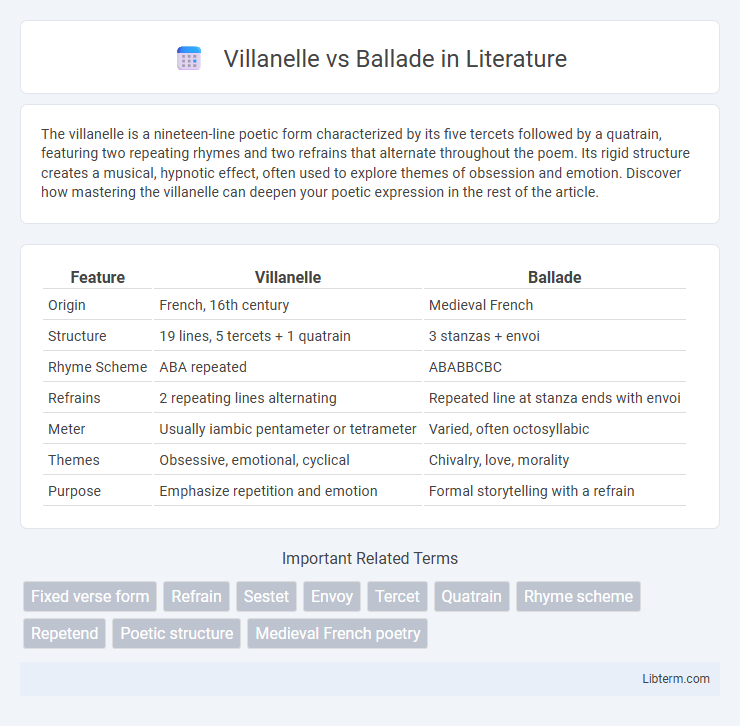The villanelle is a nineteen-line poetic form characterized by its five tercets followed by a quatrain, featuring two repeating rhymes and two refrains that alternate throughout the poem. Its rigid structure creates a musical, hypnotic effect, often used to explore themes of obsession and emotion. Discover how mastering the villanelle can deepen your poetic expression in the rest of the article.
Table of Comparison
| Feature | Villanelle | Ballade |
|---|---|---|
| Origin | French, 16th century | Medieval French |
| Structure | 19 lines, 5 tercets + 1 quatrain | 3 stanzas + envoi |
| Rhyme Scheme | ABA repeated | ABABBCBC |
| Refrains | 2 repeating lines alternating | Repeated line at stanza ends with envoi |
| Meter | Usually iambic pentameter or tetrameter | Varied, often octosyllabic |
| Themes | Obsessive, emotional, cyclical | Chivalry, love, morality |
| Purpose | Emphasize repetition and emotion | Formal storytelling with a refrain |
Introduction to Villanelle and Ballade
The Villanelle is a 19-line poetic form featuring five tercets followed by a quatrain, characterized by two repeated refrains and a specific rhyme scheme (ABA). The Ballade, originating from medieval French poetry, typically consists of three octaves and a quatrain called an envoi, following a strict rhyme pattern (ABABBCBC). Both forms emphasize repetition and rhyme but differ in structure, length, and historical context, making them distinct choices for poetic expression.
Historical Origins of Villanelle and Ballade
The villanelle originated in 16th-century Italy as a pastoral song form before evolving into a fixed French poetic form characterized by nineteen lines with two repeating refrains. The ballade traces its roots to medieval France during the 14th and 15th centuries, emerging as a prominent lyrical form in Old French poetry typically comprising three stanzas followed by an envoi. Both forms reflect distinct historical contexts: the villanelle's pastoral and rustic origins contrast with the ballade's association with courtly and narrative traditions in medieval European literature.
Structure and Form of Villanelle
The villanelle is a 19-line poetic form consisting of five tercets followed by a quatrain, characterized by two refrains and two repeating rhymes that create a cyclical pattern. In contrast, the ballade typically comprises three octaves and an envoi, following a strict rhyme scheme often ABABBCBC with a shorter final stanza. Villanelles emphasize repetition through their refrains, producing a musical and haunting effect, while ballades prioritize narrative progression within a more rigid stanzaic form.
Structure and Form of Ballade
The Ballade traditionally consists of three main stanzas of eight lines each, followed by a four-line envoi, all sharing a consistent rhyme scheme, typically ababbcbc for the stanzas and bcbc for the envoi. Each stanza's meter is usually iambic tetrameter or pentameter, reinforcing the formal and rhythmic unity characteristic of this French medieval form. The refrain, appearing at the end of each stanza and the envoi, adds a lyrical and repetitive structure that distinguishes the Ballade from the Villanelle's tercets and quatrain pattern.
Rhyme Schemes: Comparing Villanelle and Ballade
The villanelle features a strict rhyme scheme of ABA in its five tercets followed by an ABAA quatrain, with two repeating refrains interwoven throughout the poem. In contrast, the ballade typically consists of three octaves and a quatrain, employing a consistent rhyme scheme such as ababbcbc for each octave and bcbc for the envoi. These distinctive rhyme patterns underscore the villanelle's cyclical repetition and the ballade's narrative progression within fixed stanzaic constraints.
Refrains in Villanelle vs Ballade
Refrains in a villanelle are characterized by two alternating lines that repeat throughout the 19-line poem, creating a cyclical and musical pattern integral to its fixed form. In contrast, the ballade typically features a single refrain line that recurs at the end of each stanza, emphasizing the poem's narrative and rhythmic cohesion over a longer structure of 28 or more lines. The villanelle's repetitive refrains enhance thematic resonance by echoing key emotions, while the ballade's refrain serves as a leitmotif that unifies the stanzas and reinforces the poem's central message.
Themes and Subject Matter
Villanelles often explore themes of obsession, loss, and repetition, capturing emotional intensity through their cyclical structure, while ballades tend to focus on chivalry, romance, or moral lessons rooted in medieval tradition. The villanelle's subject matter frequently delves into personal despair or existential reflection, emphasizing psychological depth. In contrast, ballades traditionally address communal or heroic narratives, conveying social values and historical storytelling.
Famous Examples in Poetry
Villanelle is characterized by its 19-line structure and repeated refrains, with famous examples like Dylan Thomas's "Do not go gentle into that good night" and Elizabeth Bishop's "One Art." Ballade, a medieval French form with three octaves and a four-line envoy, is exemplified by poets such as Stephane Mallarme and Dante Gabriel Rossetti. Both forms highlight the interplay of repetition and rhyme, showcasing distinct rhythmic patterns and thematic focus in their celebrated works.
Writing Tips for Each Form
When writing a Villanelle, emphasize the repetitive structure by carefully crafting two refrains and five tercets, ensuring rhyme scheme ABA throughout to create a musical rhythm. For a Ballade, concentrate on its three octaves followed by a quatrain with a refrain, maintaining the rhyme scheme usually as ababbcbC, to deliver a dramatic narrative or emotional intensity. Both forms demand precise adherence to meter and rhyme patterns, making careful word choice essential for maintaining clarity and impact within their strict structures.
Choosing Between Villanelle and Ballade
Choosing between a villanelle and a ballade depends on the desired poetic structure and emotional impact. A villanelle features 19 lines with a strict pattern of repeated lines and rhyme, making it ideal for themes of obsession and circular thought. In contrast, the ballade's three octaves followed by a quatrain with a refrain suits narratives or themes requiring a formal, lyrical progression.
Villanelle Infographic

 libterm.com
libterm.com